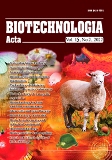ISSN 2410-7751 (Друкована версія)
ISSN2410-776X (Електронна версія)

Biotechnologia Acta Т. 15, No. 2, 2022
P. 62-63, Bibliography 4, Engl.
UDC: 616.89:615.099:599.323.4:612.08
https://doi.org/10.15407/biotech15.02.062
A. O. Mykytenko, O. Y. Akimov, K. S. Neporada
Poltava State Medical University, Ukraine
The aim of our study was to analyze changes in the development of oxidative stress in the liver of rats with chronic alcohol intoxication against the background of systemic inflammatory response syndrome based on the study of catalase and superoxide dismutase activity, concentration of malonic dialdehyde, oxidatively modified proteins and sulfide anion and superoxide anion production.
Methods. Experimental studies were performed on 12 male Wistar rats weighing 180?220 g. Animals were divided into two groups: 1 ? control and 2 ? animals, on which we simulated alcoholic hepatitis and SIRS. The activity of catalase and superoxide dismutase (SOD), the concentration of malonic dialdehyde (MDA) , oxidatively modified proteins (OMP) sulfide anion and superoxide anion production were studied in the rat liver homogenate. The obtained results were subjected to statistical processing using the Mann-Whitney test.
Results. Analyzing the development of oxidative stress in the liver of rats, on which we simulated the combined effects of SIRS and prolonged alcohol intoxication, we found that the activity of SOD increased by 1.72 times (P<0.05), and catalase decreased by 1.18 times (P<0.05) compared with the control group. The production of superoxide anion radical in the liver of rats increased 2.21 times (P<0.05) in the group of animals with combined exposure to bacterial LPS and alcohol intoxication compared to control. The concentration of MDA increased 2.25 times (P<0.05), and OMP by 9.5 times (P<0.05) compared with control group. The concentration of sulfide anion in the liver of rats under the conditions of modeling the combined effects of SIRS and alcohol intoxication decreased by 1.44 times (P <0.05) compared with the control.
Conclusions. Modeling of alcohol intoxication against the background of systemic inflammatory response syndrome leads to oxidative damage to lipid and protein structures of the liver due to increased production of superoxide anion radical and imbalance of antiradical protection.
Key words: alcoholic hepatitis, systemic inflammatory response syndrome, oxidative stress.
© Palladin Institute of Biochemistry of the National Academy of Sciences of Ukraine, 2022\
References
1. Jaruvongvanich V, Sanguankeo A, Upala S. Effect of SIRS and sepsis on mortality in alcoholic hepatitis: A systematic review and meta-analysis. Turk J Gastroenterol. 2016, 27(5), 458?463. https://doi.org/10.5152/tjg.2016.16188
2. Pandey G., Singh H., Chaturvedi S. Utility of neutrophil CD64 in distinguishing bacterial infection from inflammation in severe alcoholic hepatitis fulfilling SIRS criteria. Sci Rep. 2021, 11(1), 19726. Published 2021 Oct 5. https://doi.org/10.1038/s41598-021-99276-y
3. Ceni E., Mello T., Galli A. Pathogenesis of alcoholic liver disease: role of oxidative metabolism. World J. Gastroenterol. 2014, 20(47), 17756?17772. https://doi.org/10.3748/wjg.v20.i47.17756
4. Mykytenko A. O., Akimov O. Ye., Yeroshenko G. A., Neporada K. S. Extracellular matrix of rat liver under the conditions of combining systemic inflammatory response syndrome and chronic alcohol intoxication. World of Medicine and Biology. 2022, 79(1), 214?217.

